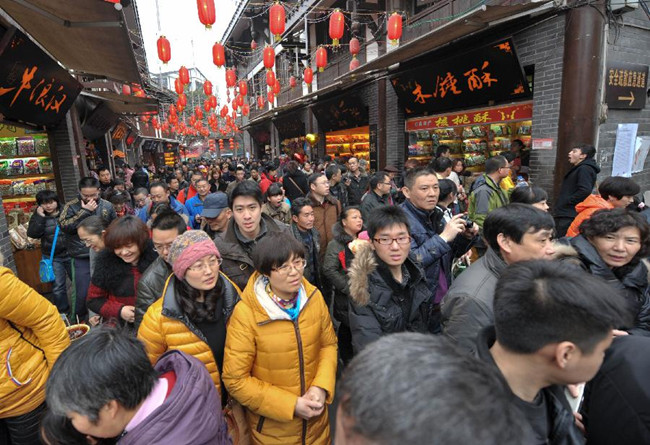 |
|
During the festivals in China, the ancient town is always full of visitors. [Photo/Xinhua] |
The main scenic spots in Ciqikou include the Zhong Family Courtyard, the Imperial Academy, Baolun Temple and Wenchang Taoist Temple. The Zhong Family Courtyard is located near the entrance to the town. It combines two different styles of traditional Chinese courtyard dwellings. The spacious entrance and the symmetrical layout present a style that is often seen in imperial gardens in North China. At the same time, the building materials and architectural structures represent the style of South China residences. Its owner Zhong Yunting worked for the Empress Dowager Cixi (1835-1908) and was in charge of purchasing rare treasures. This explains why the compound was constructed on such a lavish scale.
The Imperial Academy, now a teahouse, was originally a private school founded by the Sun family in the late Qing Dynasty. At that time, three students from this school passed the imperial examinations at the provincial level. What’s more, another two students passed the highest imperial civil service examinations and were appointed as officials attached to the Imperial Academy. The school consequently earned a good reputation.
Baolun Temple, also known as Longyin Temple, is situated on Hengjie Street. The sound of drums in the morning and bells in the evening emanating from the temple never stops and acts as call to its large numbers of worshippers and pilgrims. Climbing the stone steps, I arrived at the Tianwangdian (Hall of the Heavenly King) where a panorama of the town unfolds. Next to it is a depository of Buddhist sutras. From the top floor you can see the layout of the entire temple. What we see today dates back to the Ming Dynasty (1368-1644) when it was expanded. It is said that not a single metal nail was used in the construction of this resplendent and magnificent wood-structure hall.
Jinbi, Ma’an and Fenghuang are three major mountains in this area. The Wenchang Taoist Temple is on Jinbi Mountain and can be seen from the boats sailing along the Jialing River. Built in the Ming Dynasty, the temple enshrines Emperor Wenchang, the deity of scholarly honor and official ranks.
No visit to Ciqikou would be complete without sampling the local cuisine. Duck’s blood in chili sauce, braised tofu and peanuts with pepper and salt are vaunted as the three most delicious dishes of Ciqikou. Home-cooked hot and sour rice noodles, glutinous rice cake and chicken giblets with pickled pepper are similarly tantalizing. But the most popular food is mahua (fried dough twist) and there is no better brand than Chen Changyin. Be sure not to miss this tasty, crispy pastry.
Half a day is not long enough to fully experience Ciqikou, but I feel lucky to have had the chance to relax there and take some great photos of this lovely town. As a famous tourist destination, Ciqikou is inevitably influenced by commercial elements, but these are just superficial. Scratch the surface and you will find a town in mint condition lying on the banks of the Jialing River waiting for us to visit and reflect on in peace and quiet.
Prosperous in the past and ever popular in the present, Ciqikou retains its old style and simplicity. In which way will it develop in the future? How do we maintain its vitality? Will we still find a peaceful and serene corner at the end of those alleys? These questions played on my mind as I left the town. But I’m sure I will come back one day with great expectations.